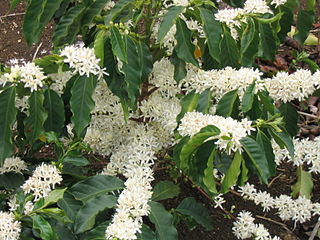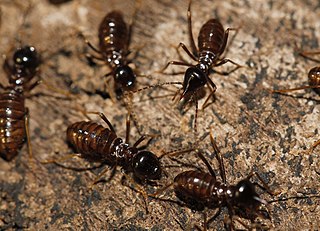Related Research Articles

Coffea is a genus of flowering plants in the family Rubiaceae. Coffea species are shrubs or small trees native to tropical and southern Africa and tropical Asia. The seeds of some species, called coffee beans, are used to flavor various beverages and products. The fruits, like the seeds, contain a large amount of caffeine, and have a distinct sweet taste and are often juiced. The plant ranks as one of the world's most valuable and widely traded commodity crops and is an important export product of several countries, including those in Central and South America, the Caribbean and Africa.

Ziziphus jujuba, commonly called jujube, red date, Chinese date, Chinese jujube is a species in the genus of Ziziphus, in the buckthorn family (Rhamnaceae).

Tagetes is a genus of annual or perennial, mostly herbaceous plants in the sunflower family Asteraceae. They are among several groups of plants known in English as marigolds. The genus Tagetes was described by Carl Linnaeus in 1753.

The chilli thrips or yellow tea thrips, Scirtothrips dorsalis Hood, is an extremely successful invasive species of pest-thrips which has expanded rapidly from Asia over the last twenty years, and is gradually achieving a global distribution. It has most recently been reported in St. Vincent (2004) Florida (2005), Texas (2006), and Puerto Rico (2007). It is a pest of economic significance with a broad host range, with prominent pest reports on crops including pepper, mango, citrus, strawberry, grapes, cotton, tea, peanuts, blueberry, and roses. Chilli thrips appear to feed preferentially on new growth, and infested plants usually develop characteristic wrinkled leaves, with distinctive brown scarring along the veins of leaves, the buds of flowers, and the calyx of fruit. Feeding damage can reduce the sale value of crops produced, and in sufficient numbers, kill plants already aggravated by environmental stress. This thrips has also been implicated in the transmission of three tospoviruses, but there is some controversy over its efficiency as a vector.
Andraca bipunctata is a moth of the family Endromidae. It is found in China (Yunnan), India, Bhutan, northern Thailand, Myanmar and Nepal. The larvae are referred to as bunch caterpillars.

The genus Helopeltis, also known as mosquito bugs, is a group of Heteropterans in the family Miridae and tribe Dicyphini. They include important pests of various crops, including cacao, cashew, cotton and tea. Now in a different subgenus, a number of similar Afropeltis species are pests in Africa.

Oligonychus is a genus of mites in the family Tetranychidae, the spider mites. Many members of this genus are familiar pests of plants. There are about 200 described species.

Hyposidra talaca, the black looper or black inch worm, is a moth of the family Geometridae. The species was first described by Francis Walker in 1860. It is found from India to Indochina, Sundaland, Sulawesi, the Philippines, Sri Lanka, the Solomon Islands, Thailand, Taiwan, New Guinea and Australia, where it has been recorded from Queensland. It is a major defoliating pest in tea plantations.

Euwallacea fornicatus is a species complex consisting of three cryptic species of ambrosia beetles, known as an invasive species in California, Israel and South Africa. As the rest of the ambrosia beetles, E. fornicatus larvae and adults feed on a symbiotic fungus carried in a specific structure called mycangium. In E. fornicatus, the mycangium is located in the mandible. The combination of massive numbers of beetles with the symbiotic fungus kill trees, even though the fungus alone is a weak pathogen.
Postelectrotermes militaris is a species of drywood termite of the genus Postelectrotermes. It is native to India and Sri Lanka. It is a serious pest of tea.
Neotermes greeni, is a species of drywood termite of the genus Neotermes. It is native to India and Sri Lanka. It closely resembles Postelectrotermes militaris. It is a minor pest of tea in Sri Lanka, and major pest of mango in India.
Kalotermes jepsoni, is a species of damp wood termite of the genus Kalotermes. It is native to India and Sri Lanka. It usually prefers to live in dead and decaying wood, but sometimes can be seen in live wood. It is a major pest of tea in Sri Lanka.
Glyptotermes ceylonicus, is a species of damp wood termite of the genus Glyptotermes. It is endemic to high elevations Sri Lanka. It is a pest of dead and decaying wood of Hevea, Theobroma, Ficus, and Acacia species.
Coptotermes gaurii, is a species of subterranean termite of the genus Coptotermes. It is native to South India and Sri Lanka. It is a serious pest of tea in Sri Lanka.
Odontotermes ceylonicus, is a species of termite of the genus Odontotermes. It is native to India and Sri Lanka. Though nests in the ground, they never construct termitaria. It attacks many dead, diseased rotten plant roots and wooden buildings. It is a major pest of sugarcane and a secondary pest of tea.

Odontotermes horni, is a species of termite of the genus Odontotermes. It is native to India and Sri Lanka. It attacks many dead, decaying trees and fertilized soil. Though nests on ground, they do not construct a termitaria. It is a pest of tea, coconut and sugarcane.
Odontotermes koenigi, is a species of termite of the genus Odontotermes. It is native to India and Sri Lanka. It is a pest of tea.
Hypotermes obscuriceps, is a species of termite of the genus Hypotermes. It is native to India, Sri Lanka and Vietnam. It constructs a termitaria and is a pest of tea.

Hospitalitermes monoceros, is a species of nasute termite of the genus Hospitalitermes. It was originally considered to be endemic to Sri Lanka, but was also found in India in 2013. It is an obligate lichen feeder. It is recorded from Cassia multijuga and Ficus religiosa trees and is a pest of tea.
Rhynocoris marginatus is a species of assassin bug in the family Reduviidae. It is a predator of other insects and is found in Asia. Crops in India on which it has been found feeding on pests include sugarcane, pigeon pea, cardamom, cotton, tea, and peanuts. The insects are potentially useful in biological control because they are more resistant to pesticides than are the pests on which they feed.
References
- ↑ Nuss, Matthias; Landry, Bernard; Vegliante, Francesca; Tränkner, Andreas; Mally, Richard; Hayden, James; Segerer, Andreas; Li, Houhun; Schouten, Rob; Solis, M. Alma; Trofimova, Tatiana; De Prins, Jurate & Speidel, Wolfgang (2003–2011). "GlobIZ search". Global Information System on Pyraloidea. Retrieved September 29, 2011.CS1 maint: discouraged parameter (link)
- ↑ "A new pest of tea in South India".